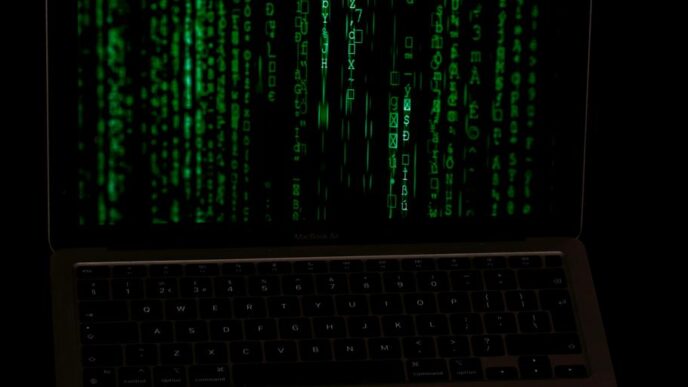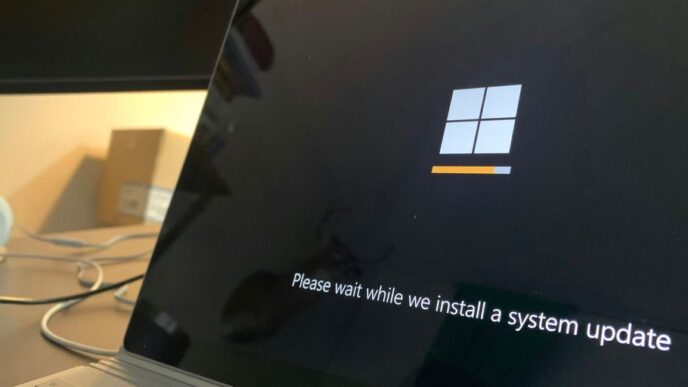The internet is everywhere now, right? We use it for pretty much everything – shopping, talking to friends, even paying bills. But with all that convenience comes some big risks. Think about all your personal info floating around out there. That’s why understanding cybersecurity law is a pretty big deal. It’s all about making sure our digital lives stay safe and sound.
Key Takeaways
- The online world is huge and always growing, connecting everything from our phones to big power grids.
- Cybersecurity law helps keep our digital stuff safe, protects important systems, and makes sure we can trust being online.
- Cyber threats are always changing, so laws and defenses need to keep up with new attacks like data breaches.
- Businesses need their own specific rules for online safety, not just generic ones.
- Everyone plays a part in cybersecurity; knowing the risks and being smart online helps a lot.
Understanding the Digital Landscape
Defining the Cyber Realm
Okay, so what is the digital landscape? It’s more than just computers and phones. It’s the whole online world where we connect, share, and do stuff. Think of it as a giant, interconnected space that’s always changing. It’s shaped by everything from social media to online shopping, and it’s constantly evolving with new tech. It’s wild to think about how much it’s changed in just the last few years. It’s not just about cat videos and memes (though those are definitely part of it). It’s also about how businesses operate, how governments function, and how we interact with each other on a daily basis. It’s a big deal, and understanding it is key to, well, pretty much everything these days. You can learn more about cyber attacks to protect yourself.
The Interconnected Digital Infrastructure
This is where things get a little more technical, but stick with me. The digital landscape relies on a complex web of stuff working together. We’re talking about:
- Networks: The internet itself, connecting everything.
- Hardware: Servers, computers, phones – the physical devices.
- Software: The programs and apps that make it all work.
It’s like a city’s infrastructure, but instead of roads and bridges, it’s all digital. If one part fails, it can affect everything else. Think about when a major website goes down – it’s usually because something went wrong with the infrastructure. And because everything is connected, security is a huge concern. A weakness in one area can be exploited to attack the whole system. It’s a constant game of cat and mouse between those trying to protect the infrastructure and those trying to break into it. It’s a lot to keep track of, but it’s important to understand the basics.
The Pervasive Nature of Online Spaces
The internet isn’t just something we use; it’s woven into pretty much every aspect of our lives. From checking email to ordering groceries, we’re constantly interacting with online spaces. This has some pretty big implications. For one, it means that our data is constantly being collected and analyzed. Companies are tracking our online behavior to target us with ads, and governments are monitoring online activity for security purposes. It also means that we’re increasingly vulnerable to online threats, like scams, phishing attacks, and identity theft. It’s important to be aware of these risks and take steps to protect ourselves. But it’s also important to remember the benefits of online spaces. They allow us to connect with people all over the world, access information instantly, and participate in democratic processes. It’s a double-edged sword, and we need to be smart about how we use it. It’s all about finding a balance between convenience, security, and privacy. It’s a challenge, but it’s one we need to address if we want to make the most of the digital age. It’s important to have robust data privacy protocols.
The Imperative of Cybersecurity Law
Cybersecurity law? It’s not just some techy thing for IT people anymore. It’s about keeping our whole digital world from falling apart. Think of it as the rules of the road for the internet, but way more complicated. It’s about protecting everything from your grandma’s email account to the power grid. Seriously.
Safeguarding Digital Assets and Information
Cybersecurity law is there to protect all the stuff we care about online. That includes your bank account info, your medical records, and even those embarrassing photos from college. If there weren’t laws in place, hackers could run wild, stealing identities and causing chaos. It’s like having a digital bodyguard for your entire life. A cybersecurity guide can help you understand the basics.
Protecting Critical National Infrastructures
Okay, this is where it gets really serious. Cybersecurity law isn’t just about personal stuff; it’s about protecting the things that keep our society running. Think power plants, water systems, and transportation networks. If someone were to hack into these systems, the consequences could be devastating. Cybersecurity laws help make sure these critical infrastructures are defended against attacks. It’s like having a digital shield around the country.
Ensuring Trust and Utility in the Online World
Without cybersecurity laws, the internet would be a scary place. Nobody would trust online banking, e-commerce, or even social media. These laws help create a safe and secure online environment where people can do business, share information, and connect with each other without constantly worrying about being hacked or scammed. It’s about building a digital fortress where we can all feel safe.
Evolving Threats and Legal Responses
The Continuous Evolution of Cyberattacks
Cyberattacks? They’re not static. What worked last year might be useless today. Think about it: criminals are always finding new ways to get in. It’s like a constant game of cat and mouse. We’ve seen a huge increase in sophisticated attacks, especially with AI-powered phishing and ransomware. These attacks are becoming more targeted and harder to detect. It’s not just about viruses anymore; it’s about complex schemes designed to exploit human error and system vulnerabilities. Staying ahead means continuous learning and adaptation.
Addressing Data Breaches and Cybercrime
Data breaches are a nightmare. Not only do they cost money, but they also damage your reputation. The legal consequences can be severe, too. We’re talking about fines, lawsuits, and regulatory actions. Companies need to have a plan in place for when, not if, a breach occurs. This includes incident response, data recovery, and notifying affected parties. Cybercrime laws are evolving to keep up, but enforcement can be tricky, especially when attacks originate from other countries. It’s a global problem that requires a coordinated response. Here’s a quick look at potential costs:
| Cost Type | Average Expense |
|---|---|
| Legal Fees | $50,000 – $500,000 |
| Notification Costs | $10,000 – $100,000 |
| Remediation | $20,000 – $200,000 |
| Business Interruption | Varies Widely |
The Dynamic Nature of Cybersecurity Defenses
Cybersecurity isn’t a one-time fix; it’s an ongoing process. You can’t just install some software and forget about it. You need to constantly update your defenses, monitor your systems, and train your employees. Here are some key elements of a strong defense:
- Regular security audits
- Employee training programs
- Up-to-date software and patches
- Strong password policies
- Incident response planning
It’s also important to remember the human element. People are often the weakest link in the chain. Social engineering attacks, like phishing, rely on tricking people into giving up sensitive information. So, cybersecurity policies should be reviewed regularly. Staying vigilant and proactive is the only way to stay safe.
Crafting Effective Cybersecurity Policies
It’s easy to think cybersecurity is just for tech companies, but honestly, everyone needs to be on board. It’s like locking your doors at night – you wouldn’t skip it, right? So, let’s talk about making some solid cybersecurity policies. It’s not as scary as it sounds, I promise.
Developing Internal Digital Safety Guidelines
Okay, first things first: you need rules. Think of it like setting ground rules for using the internet at home, but for your whole company. These guidelines should cover everything from password rules to what websites are okay to visit on company time. It’s about creating a culture where everyone thinks twice before clicking on a weird link. We need to make sure everyone knows what’s up. Here’s a few things to consider:
- Password Complexity: Make sure everyone uses strong, unique passwords. No more ‘password123’!
- Software Updates: Keep everything updated. Those updates often include security patches.
- Data Handling: Explain how sensitive data should be handled and stored. No leaving it on a USB drive in the parking lot!
Custom-Tailored Protection for Businesses
Here’s the thing: what works for a small bakery isn’t going to work for a huge hospital. You need to tailor protection to your specific business. What kind of data do you handle? What are your biggest risks? If you’re a law firm, client confidentiality is huge. If you’re an e-commerce site, protecting customer credit card info is key. It’s about figuring out what matters most and focusing your efforts there. It’s also important to define roles and responsibilities. Who’s in charge of what when it comes to security? Clear boundaries reduce risk.
Navigating Emerging Challenges with Foresight
The internet is always changing, and so are the threats. What’s safe today might be a huge risk tomorrow. That means your cybersecurity policies can’t be set in stone. You need to review and update them regularly. Think about new technologies, new types of attacks, and any changes in your business. It’s like checking the weather forecast – you need to stay informed and adjust your plans accordingly. Also, consider these points:
- Stay Informed: Keep up with the latest cybersecurity news and trends.
- Regular Audits: Conduct regular security audits to identify vulnerabilities.
- Incident Response Plan: Have a plan in place for what to do if something goes wrong. Don’t wait until you’re in the middle of a crisis to figure it out.
Legal Frameworks for Digital Protection
Distinguishing Cyber and Physical Security Laws
Okay, so, when we talk about security, it’s easy to think it’s all the same thing. But protecting your computer is way different than protecting your house. Physical security? That’s locks, alarms, maybe a guard dog. It’s about keeping people and stuff safe in the real world. Cybersecurity? That’s firewalls, encryption, and cyber security regulations. The big difference is one deals with the tangible, the other with the digital. You can touch a lock, but you can’t touch a virus. It’s like comparing apples and oranges, both fruit, but totally different.
Establishing Robust Data Privacy Protocols
Data privacy is a huge deal now. It’s not just about keeping your diary locked; it’s about companies handling your info responsibly. Think about all the data floating around – your name, address, credit card details. Data privacy protocols are the rules that say how companies can collect, use, and share that data. It’s about giving you control over your personal information. If a company messes up and leaks your data, that’s a problem. These protocols are there to prevent that, and to give you some recourse if it happens. It’s like having a digital fortress around your personal life.
Mechanisms for Redress and Punishment
So, what happens when someone breaks the rules? That’s where redress and punishment come in. If you’re a victim of cybercrime, there needs to be a way to get justice. This could mean suing the company that let your data get stolen, or it could mean the government prosecuting the hackers. The goal is to make sure there are consequences for bad behavior. It’s not always easy to catch cybercriminals, especially when they’re in another country, but having these mechanisms in place is important. It’s about building digital fortresses and holding people accountable when they try to tear them down.
The Role of Individuals in Cybersecurity Law
Cultivating Digital Awareness and Skills
Okay, so cybersecurity isn’t just for tech companies or governments. It’s something we all need to think about. The first step is just being aware of the risks out there. It’s like learning to drive – you need to know the rules of the road to avoid accidents. For example, understanding cybersecurity principles can help you make better choices online. Think about it:
- Recognizing phishing emails.
- Using strong passwords.
- Being careful about what you click on.
Recognizing and Mitigating Online Risks
It’s not enough to just know the risks; you have to do something about them. This means taking steps to protect yourself. I mean, we all know we should back up our data, but how many of us actually do it regularly? It’s like flossing – we know it’s good for us, but it’s easy to skip. Here’s a simple breakdown:
- Identify your vulnerabilities: What are you most worried about losing? Photos? Documents? Bank info?
- Take action: Use two-factor authentication, install antivirus software, and keep your software updated.
- Stay informed: The threats are always changing, so keep learning.
Becoming Responsible Digital Citizens
Being a responsible digital citizen means thinking about how your actions affect others. It’s like being a good neighbor in the real world. Don’t spread misinformation, respect other people’s privacy, and report suspicious activity. It’s about creating a safer online environment for everyone. It’s also about understanding that even small actions can have big consequences. For instance, sharing a fake news article can have a real impact on people’s lives. It’s about being mindful and thoughtful in your online interactions. Also, remember that custom-tailored protection is important, so adjust your security based on your needs.
Future Directions in Cybersecurity Law

It’s wild to think about where cybersecurity law is headed. Things are changing so fast, it’s hard to keep up! But some trends are pretty clear, and they’re going to shape how we protect ourselves online in the coming years. The future of cybersecurity law hinges on adapting to increasingly sophisticated threats and leveraging emerging technologies.
Advancements in Threat Intelligence Systems
Think of threat intelligence like a super-powered early warning system. Instead of just reacting to attacks, these systems are getting smarter at predicting them. They gather data from all sorts of sources – security reports, dark web chatter, even social media – to spot potential threats before they cause damage. This proactive approach is becoming more important as attacks get more complex and automated. Imagine a system that can identify a phishing campaign targeting your company before a single employee clicks on a malicious link. That’s the kind of power we’re talking about. It’s like having a digital bodyguard that’s always one step ahead.
The Rise of Blockchain Technology in Security
Blockchain isn’t just for cryptocurrency anymore. Its decentralized and tamper-proof nature makes it a really interesting tool for cybersecurity. One potential use is in securing data. Instead of storing sensitive info in one place, you can distribute it across a blockchain, making it much harder for hackers to access. Another application is in identity management. Blockchain can provide a secure and verifiable way to prove who you are online, reducing the risk of identity theft. It’s still early days, but blockchain could revolutionize how we think about digital safety.
International Collaboration for a Secure Digital Environment
Cybercrime doesn’t respect borders, so cybersecurity can’t either. We need countries to work together to share information, develop common standards, and prosecute cybercriminals. This is easier said than done, of course. Different countries have different laws, priorities, and levels of technical expertise. But without international collaboration, we’re just playing whack-a-mole with cyber threats. Think about it: if a hacker in one country launches an attack on a company in another, it takes cooperation between law enforcement agencies to track them down and bring them to justice. It’s a global problem that requires a global solution. Here’s a quick look at the current state of international agreements:
| Agreement Name | Focus | Participating Countries |
|---|---|---|
| Budapest Convention | Cybercrime | 50+ |
| EU Cybersecurity Act | Cybersecurity Standards | EU Member States |
| US-EU Data Privacy Framework | Data Transfers | US, EU |
Conclusion
So, we’ve talked a lot about cybersecurity law, right? It’s pretty clear this whole area isn’t just some dusty old legal stuff. It’s alive, it’s changing super fast, and it’s really important for everyone. Think about it: our lives are online now, from shopping to talking with friends. Because of that, the rules about keeping our digital stuff safe have to keep up. It’s a big job, making sure laws protect us without stopping new tech from happening. We all have a part to play, too. Knowing a bit about these laws helps us be smarter online. It helps businesses keep customer info safe. And it helps governments make sure the internet stays a good place for everyone. It’s a journey, not a destination, and we’re all in it together.
Frequently Asked Questions
What exactly is the ‘cyber realm’?
The ‘cyber realm’ is just a fancy way of saying the online world. It’s all the connected computers, phones, and other devices, plus the internet itself, where we do things like shop, talk to friends, and learn.
Why do we need cybersecurity law?
Cybersecurity law is about making rules and laws to keep our digital stuff safe. Think of it like traffic laws for the internet, but instead of cars, it’s about protecting your private info, important company secrets, and even big power grids from bad guys online.
How do online threats and laws keep changing?
Cyberattacks are always changing, like a sneaky chameleon. This means the laws and ways we protect ourselves online also have to keep changing to catch up. It’s a constant game of cat and mouse between the good guys and the bad guys.
What are ‘cybersecurity policies’ and why are they important?
Good cybersecurity policies are like a guidebook for how people and companies should act online to stay safe. They help businesses protect their customer’s information and keep their own systems from getting hacked. It’s about being smart and prepared.
How is cybersecurity law different from regular safety laws?
Cybersecurity laws are different from regular physical security laws because they deal with digital things, not physical stuff. For example, a law about not stealing a car is physical, but a law about not stealing someone’s online banking info is cybersecurity. They both aim to protect, but in different ways.
What’s my role in cybersecurity law?
Everyone has a part to play! It means learning how to be safe online, like using strong passwords and not clicking on weird links. When you’re careful, you’re helping to make the whole internet a safer place for everyone.














